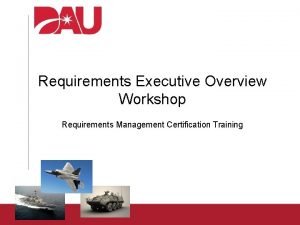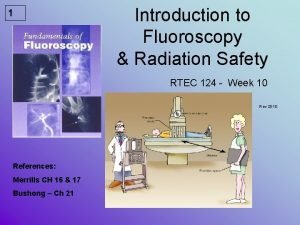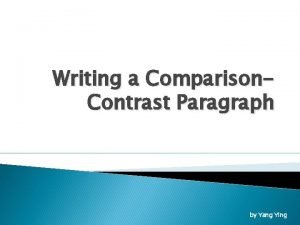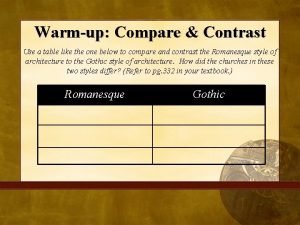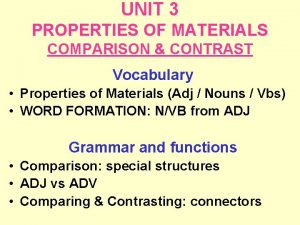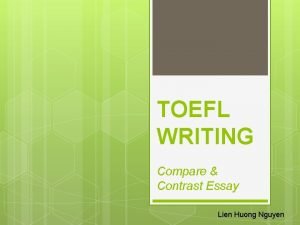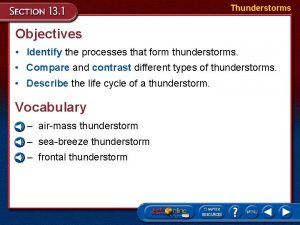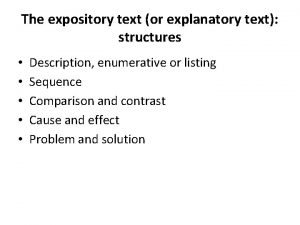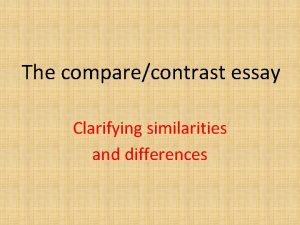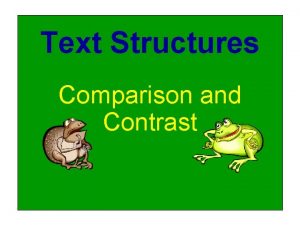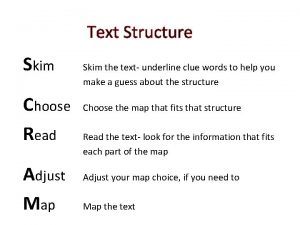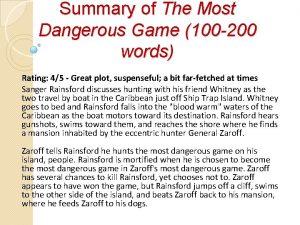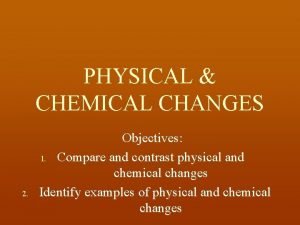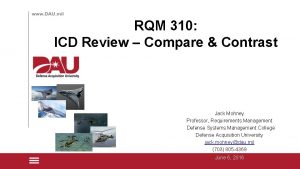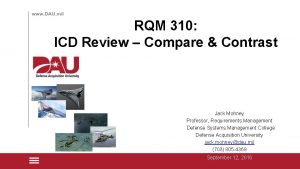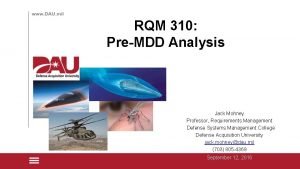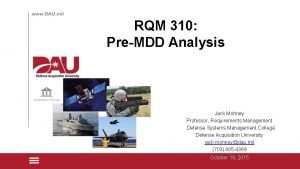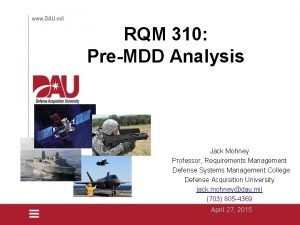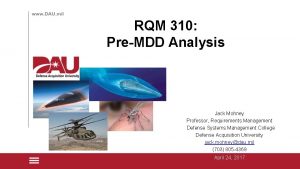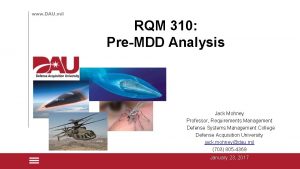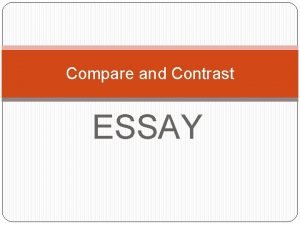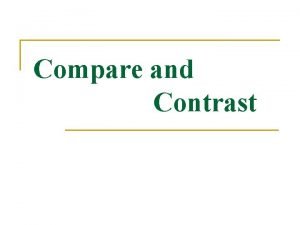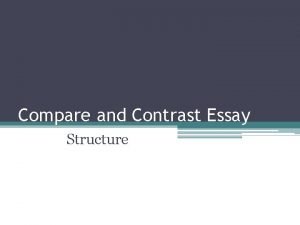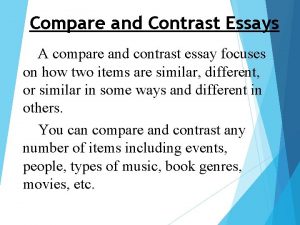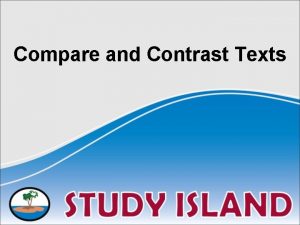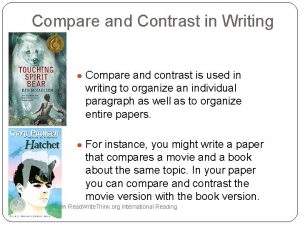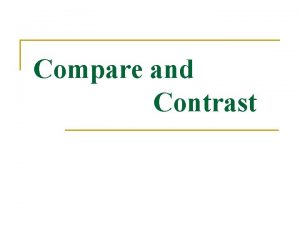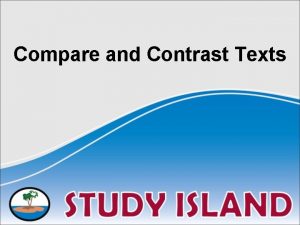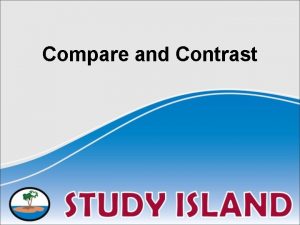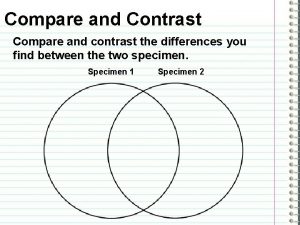RQM 310 ICD Review Compare Contrast Jack Mohney


























- Slides: 26

RQM 310: ICD Review – Compare & Contrast Jack Mohney Professor, Requirements Management Defense Systems Management College Defense Acquisition University jack. mohney@dau. mil (703) 805 4369 April 25, 2016

Lesson Objectives • Develop a more “discerning eye” when reviewing capability identification documents • Compare and contrast three actual ICDs – One JCIDS compliant, one partially compliant, and one non compliant • Build a bridge between old documents and current guidance 2

First, some questions… 3

Is JCIDS Broken? • Might it be that: – JCIDS (the process) is NOT focused on materiel solutions – while the people doing JCIDS analysis might be? • Does JCIDS fully account for existing & non materiel solutions? • Does JCIDS specify the analysis exhaust those possibilities before identifying materiel approaches? – The Pentagon is risk averse & overly bureaucratic—not just JCIDS? AND the JS intentionally built JCIDS that way? • As a taxpayer, do you want everything vetted at every level? • Whether or not it is the “right” answer? • That nobody disagrees with? 4

Bad ICDs? • There are many BAD ICDs that the validation authorities approve. Why? – – – Time Apathy / lack of equity Expertise “Back scratching” Nobody reads them…who cares? Great brief bad ICD… • Is it the process — or lack of discipline inside the process? Both? Neither? Why? 5

ICD Titles • Why might a simple title be so important? • Let’s critique these ICD titles? Specify solution? – – – – – Biometric Enabling Capability (BEC) Ground Combat Vehicle (GCV) Improved Cargo Airdrop Capability (ICAd. C) Light Mobility Aircraft (Li. MA) Airborne ISR Transport (AIT) Future Cargo Aircraft (FCA) Infectious Disease Countermeasures (IDCM) Light Utility Helicopter (LUH) Vessel to Shore Bridging (VSB) Expeditionary Fighting Vehicle (EFV) 6

JCIDS Compliance 7

Compliance • Two parts: – Content – does underlying analysis meet the intent of guidance? – Format – does the document comply with the JCIDS Manual? • Capstone guidance for CBAs / ICDs – Validation of an ICD ensures the • Capability requirements and proposed IOC/FOC meet National Military Strategy (NMS) and Combatant Commander (CCMD) need • Do. D prioritizes capability requirements that do not provide unnecessary redundancy across the Joint Force 8

Today’s C & C Limitations: • No usable ICDs developed under current JCIDS guidance: – Hence, we’ll focus on content, not format – However, we will briefly look at the differences… • J 8 JCIDS intent remains the same – Slight change in emphasis with new format 9

Document Content Changes ICD Jan 2012 • Cover Page • Executive Summary • Sections 1. CONOPS Summary 2. JCAs 3. Capability Requirements 4. Capability Gaps and Overlaps/Redundancies 5. Threat and Operational Environment 6. Assessment of Non Materiel Approaches 7. Final Recommendations • Appendices A. Architecture Data B. References C. Acronym List D. Glossary 10 pages* Feb 2015 • Cover Page • Validation Page • Executive Summary • Sections 1. Operational Context 2. Threat Summary 3. Capability Requirements and Gaps/Overlaps 4. Assessment of Non Materiel Approaches 5. Final Recommendations • Appendices A. References B. Acronym List C. Glossary D. Classified Annex (optional) 13 Pages** * In 2012 the 10 page limit applied to the body (7 sections) and Appendix A ** In 2015, the 10 page limit applies only to the body (5 sections) 10

What’s In A Title? • JROC approved all three – Jun 2009 “Armed Aerial Scout” (AAS, sponsor: USA) – Apr 2010 “Airborne Strategic Deterrence” (ABSD, sponsor: USAF) – May 2013: “Joint Health Risk Management” (JHRM, sponsor: USNORTHCOM) 11

1. Concept of Operations Summary • Describe the relevant parts of the Joint Concepts, CONOPS, and/or Unified Command Plan (UCP) assigned mission to which the capability requirements identified in the ICD contribute – What operational outcomes they provide – How they complement the integrated joint / multinational warfighting force – What enabling capabilities are required to achieve the desired operational outcomes. 12

Armed Aerial Scout (AAS) 1. Concept of Operations Summary • Identify the UCP assigned mission – “The fundamental purpose of an Armed Aerial Scout is to conduct armed reconnaissance, security operations, and attack missions in support of full spectrum operations. In doing so, it improves the commander's ability to maneuver and concentrate superior combat power against the enemy at the decisive time and place. ” (FM 3 04, Attach Rec Helo Ops, 2007) • Operational outcomes – “The precise application of combat power and effective synchronization of maneuver and supporting fires require a current and accurate picture of the enemy's current dispositions and activity within a given area of operations. An Armed Aerial Scout plays a critical role in providing this information and provides advantages over other intelligence sources by countering enemy deception efforts, providing improved real time situational awareness and assessing terrain. ” 13

Airborne Strategic Deterrence (ABSD) 1. Concept of Operations Summary • Identify the UCP assigned mission – CDRUSSTRATCOM is the lead combatant commander for strategic deterrence planning and is responsible for executing strategic deterrence operations. ” Unified Command Plan, 17 Dec 2008, p. 27 – The capabilities identified in this Initial Capabilities Document (ICD) directly contribute to the deterrence mission as identified in USSTRATCOM’s Deterrence Operations Joint Operating Concept (DO JOC) , tasks established in the Unified Command Plan and requirements ……. • Operational outcomes – (a) assure friends and allies, (b) dissuade potential adversaries from developing or expanding inventories of (c) deter potential adversaries • Integrate into the joint / multinational warfighting force – deterrence capabilities complement the joint warfighter’s integrated campaign plan preventing the need to escalate to armed conflict. 14

Airborne Strategic Deterrence (ABSD) 1. Concept of Operations Summary • Identify enabling capabilities to achieve operational outcome – Enabling capabilities required to achieve Assurance, Dissuasion And Deterrence (ADD) include: • an understanding of allied and adversary goals, priorities and values • an effective Intelligence, Surveillance and Reconnaissance (ISR) providing early warning, assessing programs and threats, adversary behaviors and intentions, targeting, and post attack analysis • a secure, survivable Command, Control and Communications • the building and cultivation of strategic partners • the maintenance of a robust and responsive conventional and nuclear industrial base to sustain capabilities over time and • an effective hedge against technical and/or geopolitical uncertainties. 15

2. Joint Capability Areas (JCAs) • • Cite the applicable Tier 1 and Tier 2 JCAs Range of military operations Timeframe for IOC based upon input from CCMD / AQ Relevant Integrated Security Constructs (ISC), if applicable Integrated Security Constructs (ISCs) - Developed as part of the Do. D Analytic Baseline. ISCs contain scenarios for major combat operations. Military objectives of the ISCs provide a source for developing the list of required capabilities. 16

Armed Aerial Scout (AAS) 2. Joint Capability Areas (JCAs) • Cite the applicable JCAs – – Battlespace Awareness Force Application Command Control Net Centric • Timeframe – timeframe from 2015 through approximately 2024 • Relevant Defense Planning Scenarios (DPS, now ISC) ? ? ? • Range of military operations – – – – Conventional Warfare Forcible Entry Unconventional Warfare Show of Force Peace Enforcement Peacekeeping Operations Normal and Routine Military Operations 17

Airborne Strategic Deterrence (ABSD) 2. Joint Capability Areas (JCAs) • Cite the applicable JCAs – ABSD capabilities reside in FA, supporting the Maneuver and Engagement Tier 1 & 2 JCAs – Supporting capability areas include: Battlespace Awareness (BA), Command Control (C 2), Corporate Management (CM), Force Support (FS), Net Centric (NC) and Protection (FP) • Range of military operations • Timeframe – a 2020 threat environment. • Relevant Defense Planning Scenarios (DPS – now ISC) – The ABSD CBA was informed by Defense Planning Scenarios (DPS) 2 4 (Bipolar, Multi polar and Global Insurgency worlds). Table 2. 1 lists the Steady State Security Posture (SSSP) vignettes – Deterrence capabilities are applicable across the entire Range of Military Operations (ROMO) 18

3. Capability Requirements • Describe capabilities required in CBA or other study – Why are they essential to Sponsor to achieve goals / objectives – Relate to Concept, CONOPs, UPC assigned mission • Address compliance with OSD, Joint, National, International, policies and regulations • Define capability requirements in JCA lexicon – UJTLs / METLs – Relevant Range of Military Operations – Timeframe Under Consideration • Operational attributes, qualitative parameters, metrics – Minimum value below which capability will no longer be effective UJTL: Universal Joint Task List METL: Mission Essential Task List 19

Armed Aerial Scout (AAS) 3. Capability Requirements • Describe capabilities required in CBA – …the need for an Armed Aerial Scout to enable dominant maneuver for the joint air ground maneuver force by providing aggressive combined arms reconnaissance. • Why are they essential for JFC to achieve objectives cost armed – The Joint Force Commander (JFC) requires a relatively low cost, aerial scout platform that requires minimal training support, is supportable within the planned logistics environment, affordable with lifecycle and is the planned level of logistics resources throughout the lifecycle, interoperable with organic and joint fires systems and manned/unmanned aviation platforms. 20

Armed Aerial Scout (AAS) 3. Capability Requirements • Capability is required to comply with OSD, Joint, National policies – ? ? ? ? • Identify JCAs to which capability contributes – – Force Application Command Control Net Centric Protect • Use JCAs to describe capabilities – The Armed Aerial Scout capability gap has been repeatedly identified in previous studies and analysis including: ……. – current rotary wing aircraft employed by Army aviation in the armed reconnaissance role have shortcomings in performance, lethality, interoperability and survivability. 21

Airborne Strategic Deterrence (ABSD) 3. Capability Requirements • Describe capabilities required in CBA – These required capabilities (listed alphabetically) from the CBA formulated the ICD recommendations. • • • (U) Adaptable (U) Clear/Visible. (U) Credible (U) Effective. (U) Endurable. (U) Global in Coverage. (U) Persistently Present. (U) Responsive. (U) Survivable. (U) Tailorable. 22

Airborne Strategic Deterrence (ABSD) 3. Capability Requirements • Capability is required to comply w/OSD, Joint, National policies – above capabilities are essential because they provide credible deterrent tools to the National Command Authority and the Joint Force Commander to achieve military objectives which support Assurance, Dissuasion and Deterrence (ADD). • Identify JCAs to which capability contributes – directly support both Maneuver and Engagement in the Force Application (FA) Tier 1 JCA. • Use JCAs to describe capabilities – The ABSD capabilities do not apply to any Tier 1 & Tier 2 JCAs that have been prioritized by the SWar. F process. The STRATCOM SWar. F process identified nuclear strike attributes but did not prioritize JCAs – These capabilities are rooted in previous USSTRATCOM deterrence analysis and refined in the USSTRATCOM Senior Warfighter Forum (SWar. F). A crosswalk of SWarf attributes with ABSD capabilities is found in Appendix I SWar. F: Senior Warfighter Forum (defunct…) 23

Other Sections: • We’ll stop here… – – Section 4, Capability Gaps and Overlaps/Redundancies Section 5, Threat and Operational Environment Section 6, DOTm. LPF P Section 7, Final Recommendations 24

Jan 2012 • Cover Page • Executive Summary • Sections 1. CONOPS Summary 2. JCAs 3. Capability Requirements 4. Capability Gaps and Overlaps/Redundancies 5. Threat and Operational Environment 6. Assessment of Non Materiel Approaches 7. Final Recommendations • Appendices A. Architecture Data B. References C. Acronym List D. Glossary 10 pages* Document Content Changes ICD Feb 2015 • Cover Page • Validation Page • Executive Summary • Sections 1. Operational Context 2. Threat Summary 3. Capability Requirements and Gaps/Overlaps 4. Assessment of Non Materiel Approaches 5. Final Recommendations • Appendices A. References B. Acronym List C. Glossary D. Classified Annex (optional) 13 Pages** * In 2012 the 10 page limit applied to the body (7 sections) and Appendix A ** In 2015, the 10 page limit applies only to the body (5 sections) 25

Bottom Line for Do. D ICDs: • • Regardless of format, you just might have a “Bad” ICD if it… Has the solution in the title …. . Clearly states “No CBA or comparable analysis was conducted…. . Refers only to Lessons Learned and Past Studies…. . Makes no mention of Joint Operations…. . Has a timeframe of last year, this year, or next year…. . Makes no reference to any DPS (ISC) or joint warfighting scenarios…. . Makes no reference to why mission accomplishment needs these capabilities. . . • Lists solutions instead of approaches to solutions…. . • Does not describe any significant non materiel analysis & rationale…. . • And finally the OV 1 does not show all 5 Services! 26
 Gebhardt rqm
Gebhardt rqm Defense requirements management
Defense requirements management Jack and the beanstalk character traits
Jack and the beanstalk character traits Double contrast vs single contrast
Double contrast vs single contrast How to start compare and contrast paragraph
How to start compare and contrast paragraph How is a comparison and contrast paragraph written
How is a comparison and contrast paragraph written Point-by-point essay examples
Point-by-point essay examples Us prior to brown map key
Us prior to brown map key Draw and label transverse wave
Draw and label transverse wave Smkvqmuzwv4 -site:youtube.com
Smkvqmuzwv4 -site:youtube.com T table compare and contrast
T table compare and contrast Romeo and juliet west side story comparison chart
Romeo and juliet west side story comparison chart Compare and contrast vocabulary
Compare and contrast vocabulary Floral shops bookstores and farms are examples of
Floral shops bookstores and farms are examples of Coherence transition words
Coherence transition words Point-by-point arrangement
Point-by-point arrangement Compare and contrast cold wave and wind chill factor
Compare and contrast cold wave and wind chill factor Quantum mechanical model
Quantum mechanical model Compare and contrast narrative expository and explanatory
Compare and contrast narrative expository and explanatory Compare definition
Compare definition Compare and contrast analog and digital forecasting
Compare and contrast analog and digital forecasting Compare and contrast hurricanes and tornadoes
Compare and contrast hurricanes and tornadoes Contrast signal words
Contrast signal words Compare and contrast clue words
Compare and contrast clue words The most dangerous game summary
The most dangerous game summary Transverse and longitudnal waves
Transverse and longitudnal waves Compare and contrast physical and chemical changes
Compare and contrast physical and chemical changes

